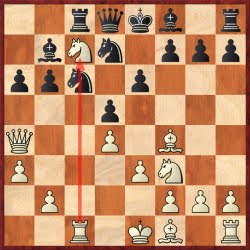My first book “A Course in Chess Tactics” is out in shops now. Here is how it starts, and the first annotated game:
The pin is one of the most common tactical methods in chess. By using a line piece (a queen, a rook or a bishop) we can connect opponent’s piece, and freeze it partially or definitely not to move under the threat of losing a more important piece. If the pin is toward the king then we speak about “dead” pin and the pinned piece definitely cannot make a move. Ordinary is the pin towards any other piece.
The fact that the pinned piece usually protects another important one could be used by us for attacking it, and eventually destroying it. The lower valued the secondary attacking piece is, the better the threat becomes (pawns are ideal for the purpose). Otherwise, if we attack the pinned piece by a piece that is as the same value as it we are just exchanging it.
Another method of collecting the pinned piece is by putting more hits onto it than our opponent can possibly do.
Pinned piece is predictable in its actions, and is less mobile than usual. It can hardly use all the potential of its energy.
However, we must take into consideration the fact that a pin is a temporary advantage that must be used promptly. Otherwise our opponent can escape, or break the pin.
Exemplary Game:Dreev,A (2650) - Seirawan,Y (2600) Wijk aan Zee, 19951.d4 Nf6 2.Nf3 e6 3.c4 b6 4.a3 c6 5.Nc3 d5 6.cxd5 cxd5 7.Bf4 a6 8.Rc1! Bb7 White is better developed, and already has some tactical threats-[8...Be7? 9.Na4!+-Threatening Bf4-c7, Na4xb6, or even Rc1xc8]
9.e3  9...Nc6?!
9...Nc6?! Black is behind in development. With this move he gives an additional opportunity for his opponent to make use of a pin. [9...Be7 10.Na4! (10.Nb5 axb5 11.Bc7 Qc8 12.Bxb5+ Nbd7 13.Bf4=) 10...Nc6 (10...Bd6 11.Qb3 Bxf4 12.exf4 Nbd7 13.Bd3 0–0 14.0–0±) 11.Ne5 Nxe5 12.Bxe5 Bd6 13.Bxd6 Qxd6 14.Qc2±; 9...Nbd7 was the best choice, giving White only a slight edge]
10.Nb5! The "Troya knight" is untouchable, due to the pin.
10...Rc8 [10...axb5 11.Bxb5 Rc8 12.Qa4 or 12.Ne5 puts unbearable pressure onto the pinned knight and Black has to part either with it, or with his bishop after Bf8-c5 which leaves White completely winning. Note that White has the opportunity to quickly bring many hits on the pinned piece.]
11.Qa4 Nd7 [11...Qd7 was an alternative try to break the pin from the white queen. However after: 12.Ne5 Nxe5 13.Rxc8+ Bxc8 (13...Qxc8 14.Nd6+) 14.Bxe5± White preserves his advantage.]
12.Nc7+ 
Dreev wants to use the pin, this time towards his opponent's queen. Reasonable alternative was: [12.Nd6+ when Black has a defensive resource: 12...Bxd6 13.Bxd6 Nxd4! (Discovered attack!) 14.Rxc8 Nxf3+ 15.gxf3 Qxc8 16.Kd2! where Black's king should stay in the center, and White posses a strong bishop pair.]
12...Rxc7 13.Bxa6!? Tricky move, which intends to deprive Black from the option: [13.Bxc7? Qxc7 14.Bxa6 Ndb8 15.Bxb7 (15.Bb5 Bd6) 15...Qxb7 … b5 and Black is ready to break the pin. After: 16.Ne5 b5 17.Qc2 Nxe5 18.Qc8+ Qxc8 19.Rxc8+ Kd7 20.Rxb8 White still looks somewhat better, but the discovered attack levels the chances: 20...Bb4+ 21.axb4 Rxb8 22.dxe5 Rc8 23.Kd2 Rc4=]
13...Bxa6?! Black follows the stream, and ends up in difficult situation. [13...Ndb8!

additionaly supporting the pinned knight was still possible. In his notes Dreev points out the "refutation": 14.Bxb7 Rxb7 15.Bxb8? (15.Qb5!?) 15...b5 16.Qa6 but misses the simple: 16...Rb6 17.Qa8 Nxb8 where Black wins. Obviously Dreev would have to go for the line mentioned above where Black levels the chances. Why does this happen? The reason is logical-White does not use all his pieces either. Black did not commit such a terrible error in the opening. However his defense was never easy, and the chance to commit mistake(s) was much higher than his opponent.; for instance the natural 13...e5 does not solve the problems- 14.Bxb7 Rxb7 15.Qxc6]
14.Bxc7 Qxc7 15.Rxc6 Qb7 16.Ne5 White now has a rook and a pawn for two pieces, but he controls the vital open line, and still uses the pin to hinder his opponent's development.
16...Be7 17.b4! f6 In case of: [17...Bc4 18.Rxb6! is much better move than Dreev's idea 18.Ne5-c4. 18...Qxb6 19.Qxd7+ Kf8 20.Nc6 wins for White.]
18.b5 Bxb5 19.Qxb5 fxe5 20.0–0! [20.Rxe6 exd4 21.0–0 Kf7 22.Rc6 Nf6]
20...exd4?! [20...Kf7 21.Rfc1 Bd8? 22.Rc7!+- loses, but in my opinion Black was obliged to castle at any rate:; 20...0–0 21.Rxe6]
21.Rfc1! Kd8?! Finally Seirawan collapses under the pressure. Dreev gives one more instructive line: [21...Bd8 only move 22.Rxe6+ Kf7 23.Rcc6 Nf6 (23...Nc5 24.Red6 Be7 25.Rxd5 dxe3 26.Rf5+) 24.e4! dxe4 25.Qc4 Kg6

and now a cunning use of the pin: 26.Qxd4 Kf7 27.Qc4 Kg6 28.Qxe4+ Kf7 29.Rxf6+!+-]
22.exd4! The Russian prefers to attack, rather than defend in the line: [22.Rc8+ Qxc8 23.Rxc8+ Kxc8 24.Qc6+ Kb8 25.Qxd7 Rc8!]
22...Rf8 23.a4!+- 
The pawn on b6 is pinned now...
23...Bg5 24.R1c2 Rf4 25.a5 Rxd4 26.g3 Rd1+ 27.Kg2 Ra1 28.axb6 Nb8 There is no salvation anyway, since after: [28...Qa6 29.Qxa6 Rxa6 30.b7 Rxc6 31.Rxc6 Bf6 32.Rd6 the pawn goes into queen.]
29.Rd6+ 1–0 More to follow soon.











